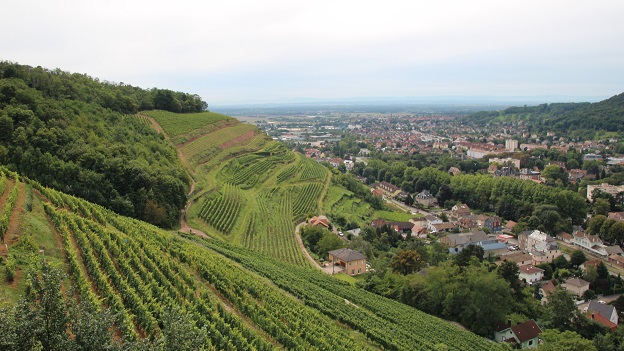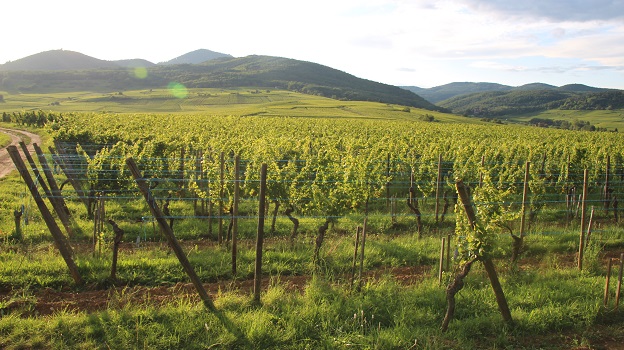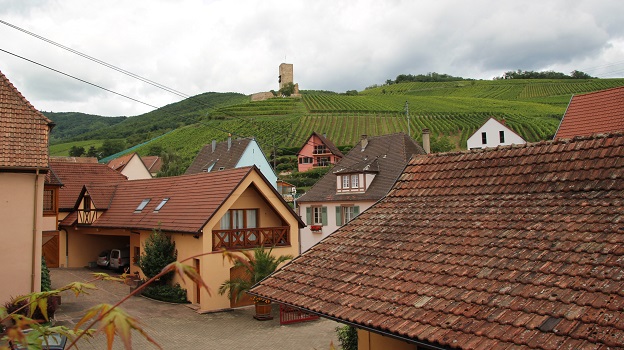Browse using the new Vinous website now. Launch →
Printed by, and for the sole use of . All rights reserved © 2015 Vinous Media
Alsace 2012s and Early-Released 2013s
If I were banished to a desert island and allowed to bring an infinite supply of just one white wine, my pick would be a Riesling, either from Alsace or the Mosel. The only other white wine that would garner even a fleeting second thought would be an Alsatian Gewürztraminer, on account of its uniqueness and entertainment value.
In fact, what most distinguishes Alsace from other white wine meccas such as Burgundy or the Mosel is that it offers wine lovers not just one but numerous outstanding wines made from multiple grape varieties. Another positive is that the region is heaven for terroir lovers. The best sites for each grape variety have been identified over a period of centuries; as was the case in Burgundy, the heads of local abbeys and the nobles who ruled over each village were keenly aware of the plots from which the best wines came, and they selected wines - and levied taxes - accordingly. Alsace also benefits from having one of France’s highest percentages of total vineyard area farmed organically or biodynamically -14%, and growing each year. And it speaks volumes about the winemaking skills of the region’s producers that the majority of their organic and biodynamic wines are quite drinkable, when so many are flawed. While I appreciate the effort to make wines from organic grapes, I worry that fashion has caused many to jump on a generalized “natural” bandwagon in which wines are characterized by, for example, excessive volatile acidity or acetaldehyde notes, i.e. a bruised apple smell. Happily, in Alsace, many estates engaged in wine production from organic grapes make lovely wines.
Overlooking Schlumberger's Grand Cru Kitterlé Vineyards, towards Guebwiller
The Issue of Sweet “Dry” Wines
If there is one problem with white wines from Alsace, it’s that over the last 20 years many wines that are marketed as dry have included a fair amount of residual sugar. This tendency can often be chalked up to producer preference. “Many in Alsace view a wine with 20 grams per liter of residual sugar as a dry wine and that’s just not so,” said Rémy Gresser. Climate change is also a factor, as warmer days lead to riper grapes. Since 2003, the average date of flowering is a good month earlier than it was as recently as the 1980s.
According to Yann Béyer of Léon Beyer, another factor explaining the tendency of producers to make slightly sweet “dry” wines is that “too many estates in Alsace sell most of their wines right out of their homes. In such cases, wines carrying a little more residual sugar might sell more easily, but wines that are mainly exported cannot and should not be like that. Not only is the aromatic quality of our wines lost when the grapes are overripe, but they don’t speak of the diverse Alsace terroirs.” Beyer exports 80% of their total production, but the average in Alsace is 30%, and this disparity can lead to very different viewpoints on the subject of residual sugar.
On the whole, however, sweetness levels have been largely scaled back during the last five years. Many producers are now using a handy numerical scale on their back labels to help their customers anticipate the sweetness level of the wines. Unfortunately, not all producers have agreed to use such scales, so some vigilance - or knowledge about the producer - is required when buying these wines. Trimbach, to take one example, makes resolutely dry wines.
Very ripe, sugar-laden grapes yield wines with potentially high levels of alcohol, so it is not surprising that the better Alsace estates have changed their viticultural methods in an effort to produce grapes that achieve phenolic ripeness earlier. This ideally results in lower alcohol levels in the finished wines.
Though the region and its wines are back on track, the excessive sweetness and unwieldy alcohol of the past several years has caused some customers to stray. However, those wine lovers who might pass on Alsace’s greatest wines for being too sweet or powerful would be doing themselves a disservice. There is no doubt in my mind that the most distinctive Gewürztraminers in the world - both dry and sweet - come from Alsace, and the same is true of Pinot Gris, although the Italian in me cringes to admit it. Some of the world’s best dry Rieslings are also from Alsace. I personally believe that Trimbach’s iconic Clos Ste. Hune is numero uno in that category. And in Alsace, the fireworks don’t stop with these three signature varieties. The region’s producers are also remarkably adept at turning out Sylvaner at a level of quality only reached in parts of Germany and Italy; and there are almost too many delicious White Muscat, Pinot Blanc and Auxerrois wines to mention.
Clos St.Landelin
Coming Soon in Alsace Wine
Alsace has done arguably the best government-sponsored research in the wine world on the geology of its viticultural production zones (yes, better even than Burgundy). The Alsace Grand Cru classification, first launched in 1975, has identified more than 50 Grand Crus, though many of their boundaries were drawn up far too generously, mainly owing to political considerations. Other great sites, however, weren’t included in the classification, such as many high-quality walled vineyards, or clos. Moreover, until now there has been no system for recognizing the quality level of specific lieux-dits, which are often the qualitative equivalents of lesser Grand or Premier Crus.
To address this, France’s INOQ (formerly known as the INAO, the entity that delimits and administers appellations) is currently at work creating two new Alsatian appellations, modeled after Burgundy’s hierarchical system. These new classifications will be Cru Communal, akin to Burgundy’s village-level, and Premier Cru. The CIVA (Le Comité Interprofessionel des Vins d’Alsace, or Alsace vintners’ association), is enthusiastic about the proposal and is actively collaborating with the government body to determine which sites should be named Premier Cru and which communal, and what the production guidelines should be in terms of maximum allowed yields, vine density, minimum alcohol levels, the presence or absence of oak, and so on. This new classification system is likely to go into effect within the next few years, and I believe it will be of great help to the wines, producers and marketplace success of Alsace.
Vineyards around Bergheim
The 2012 and 2013 Vintages - What the Producers Say
The 30-plus producers I spoke with during my two trips to Alsace last year were largely in sync on the subject of the 2012 and 2013 vintages. Most of them are happy with their 2013s but find them a touch less fat than their 2012s, which they generally view as the better of the two sets of wines. Jean Trimbach summed things up succinctly: “It’s hard to choose between 2013 and 2012. Purists love the generally higher acidity and litheness of the ’13s, but other consumers are probably going to be smitten by the balance of the ’12s.”
The 2013 vintage was quite cold, with late flowering, a challenging summer that saw both heat stress and August hail, and a rainy fall, while 2012 featured a more classic growth cycle and an even growing season. Interestingly, some producers I visited in 2014 mentioned that both consumers and journalists had gotten accustomed to one opulent vintage after another in Alsace, but that 2012 and 2013 were throwbacks to the days of old. I am not sure I agree with the “many recent opulent vintages” comment, as anyone tasting the brisk, minerally 2008s or great, high-acid 2010s would have a hard time describing these wines as lush. Without doubt, those who harvested too soon in 2013 risked making green wines, but many producers nonetheless pulled the trigger early due to their worries about possible autumn rains.
In fact, roughly 60 millimeters of rain fell without much of a break after October 8, and the grape skins began to crack open. Clearly, 2013 was a problematic year for those producers who are less conscientious about limiting yields. Marc Hugel told me that in 2013 his family operation harvested over a period of four weeks, which was both faster than normal (they usually take six or seven weeks) and came earlier, “but in 2013 those who waited too long ended up either losing their crop or having huge disease problems.”
The most successful estates in 2013 were those that harvested as late as possible before the rains started. Pinot Gris was the most successful variety; in fact, some top bottlings from other varieties were not even made. For example, Léon Beyer did not produce a 2013 Comtes d’Eguisheim, their top Gewürztraminer cuvée. André Ostertag echoed the view of many of his colleagues when he said that “in 2013 the best wines were the Pinots: their aromas and flavors are especially fresh and precise because of total acidity levels that are most often associated with our Rieslings. And because they were harvested earlier, they were also able to escape the rains, while Riesling had problems with rot.”
Other producers seemed to prefer 2013 to 2012. According to Cathérine Faller of Domaine Weinbach, “although they are two very different vintages, 2013 reminds me of 2008, another year when acidity ruled.” Jean Trimbach noted that 2013 called to mind 1996, “but the ’13s are much better and purer, and less marked by overripe quince aromas and flavors, and by grey rot.” According to Pierre Trimbach, “some winemakers were initially so worried about the potential acidity of their wines in 2013 that they even carried out malolactic fermentations, and many of these wines are now heavy and tough. But even though the ’13s that were made in classic fashion are high-acid wines, they generally come across as surprisingly rich.”
This richness is largely explained by the low production levels in 2013. At many top estates, yields were the lowest since World War II, especially for Pinot Gris. Some properties reported yields as low as 25 hectoliters per hectare, a level almost unheard of for this notoriously productive variety. I remember André Ostertag making a very interesting observation: “Two thousand thirteen would have been called an outstanding vintage in the 1980s because it would have seemed superripe, while today it’s almost looked upon as a cold vintage, and that really wasn’t the case.” Marc Hugel believes that the 2013s will be ready sooner than the 2012s. “I find that my 2103s are very forward and open already, so it will be interesting to see how they develop,” he told me.
Also, there was limited production of late-harvest wines in 2013. “Once it began raining it didn’t stop, and we were unable to make any Vendange Tardive or Sélection de Grains Nobles wines, the first time in 40 years that this happened to us with Gewürztraminer,” recalled Ostertag.
The 2012 vintage posed no significant problems, though humidity in the spring led to some mildew issues and a hotter-than-usual August stressed some younger vines. Certainly, the first part of September 2012 was ideal: I was visiting Alsace for an earlier article and I recall that it was very warm and sunny during the two weeks of my visit. Philippe Blanck characterized 2012 as “a year of classic, lovely wines.” Ostertag noted that “2012 was very uniform quality-wise: all of our cultivars performed admirably, so it’s hard to say which grape was most successful.”
Actually, although opinions vary, most producers I talked to believe that Gewürztraminer fared best in 2012. Curiously, many told me that these wines demonstrate cool-climate personalities, with fresh acidity, but I wonder if their perceptions aren’t colored by comparisons to the previous, very hot 2011 vintage. I don’t view 2012 overall as especially cool, and I find that the wines have generally soft acidity and are surprisingly ready to drink, with very accessible aromas and flavors.
In fact, Maxime Barmès of Barmès-Buecher noted that the 2012 wines reminded him of the 2007s, but with more overall acidity. Unlike in 2013, in 2012 the fall weather was nearly perfect all through the harvest. “We harvested slowly and leisurely, over seven weeks,” said Barmès, “but at the end I couldn’t wait for it to be finally done; it never seemed to be over.” According to Barmès, the harvest was extended because “there were some scattered rain showers that briefly caused us to stop harvesting for a few days, thereby stringing things out, but the weather was warm and mostly dry overall, with no prolonged heat spikes, no grey rot, and long hang times that allowed for more complex grapes.” There was also noteworthy diurnal temperature variation and the wines reflect this, with most of them showing lively acidity. However, it was not a great year for botrytis wines because of the relatively cool late-season weather and the rains that ruined what little noble rot had managed to form.
The village of Katzenthal with Chateau du WIneck and Grand Cru Wineck-Schlossberg in the background
My View of These Vintages
My own take on 2013 and 2012 is that both growing seasons produced many charming, very good wines that will generally offer early appeal, with the 2013s requiring a bit more patience due to their higher acidity levels. Neither vintage is in the style of the high-acid 2010s or 2008s, or of riper years like 1990, 1983, 1976, 1971 or 1967. I don’t believe that either vintage will prove to be especially ageworthy, although 2013 will certainly last longer than 2012. It’s worth noting that alcohol levels in both years are lower than in some recent vintages, which is another plus for the ’13s and ’12s.
This report covers Alsace wines from the 2012 vintage and early releases from 2013 - usually entry-level wines. As we will be stepping up our coverage of Alsace on Vinous, I will be reviewing later releases from the 2013 vintage - mostly grand crus and late-harvest wines - during the second half of this year. One final note: acidity figures provided in this article are expressed in tartaric acidity (normally used in Alsace as well as in Germany), which is roughly 1.5 times acidity expressed as sulfuric (the scale normally used in Burgundy).
Photo credit: Lingzi He
-- Ian D’Agata
Show all the wines (sorted by score)
- Agathe Bursin
- Albert Boxler
- Albert Mann
- Barmès-Buecher
- Dirler-Cadé
- Domaine Albert Seltz
- Domaine Bott-Geyl
- Domaine Eric Rominger
- Domaine Ernest Burn
- Domaine Marc Kreydenweiss
- Domaine Meyer-Fonné
- Domaine Paul Blanck
- Domaine Rémy Gresser
- Domaine Trapet
- Domaine Valentin Zusslin
- Domaine Weinbach
- Gustave Lorentz
- Hugel
- Jean-Baptiste Adam
- Josmeyer
- Kuentz-Bas
- Léon Beyer
- Marcel Deiss
- Ostertag
- René Muré - Clos Saint Landelin
- Schlumberger
- Schoffit
- Trimbach
- Zind Humbrecht




